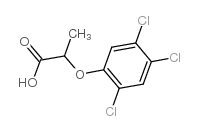Clofibrate pretreatment in mice confers resistance against hepatic lipid peroxidation.
F A Nicholls-Grzemski, G B Belling, B G Priestly, I C Calder, P C Burcham
文献索引:J. Biochem. Mol. Toxicol. 14(6) , 335-45, (2000)
全文:HTML全文
摘要
Pretreatment with peroxisome proliferators protects mice against various hepatotoxicants. Since our previous work suggested that the hepatoprotection may involve an increased ability to cope with oxidative stress, the present work directly addressed this possibility. Several observations indicated a heightened defense against oxidative stress accompanies the hepatoprotection produced by clofibrate. Firstly, the carbonyl content of hepatic proteins from clofibrate-pretreated mice was 40% lower than those from vehicle-treated controls. Secondly, liver homogenates from clofibrate-pretreated mice produced less thiobarbituric acid reactive substances upon incubation under aerobic conditions or exposure to ferrous sulfate. This effect was not due to lower levels of peroxidation-prone polyunsaturated fatty acids in clofibrate-treated livers. Thirdly, in vitro experiments indicated that the antioxidant factor in liver homogenates from clofibrate-pretreated mice was not glutathione. Rather, since it was inactivated by proteases and heat treatment, we concluded that a protein is involved. Collectively, our results suggest that a resistance to lipid peroxidation develops in mouse liver during exposure to clofibrate. The identity of the putative antioxidant protein and its contribution to the protection against liver toxicity observed in this and other laboratories awaits future investigation.
相关化合物
| 结构式 | 名称/CAS号 | 分子式 | 全部文献 |
|---|---|---|---|
 |
2,4,5-涕丙酸
CAS:93-72-1 |
C9H7Cl3O3 |
|
Quantitative structure-activity relationship and complex net...
2008-11-13 [J. Med. Chem. 51 , 6740-51, (2008)] |
|
Phenoxy herbicides and fibrates potently inhibit the human c...
2009-11-12 [J. Med. Chem. 52 , 6931-5, (2009)] |
|
Automated dynamic liquid-liquid-liquid microextraction follo...
2005-08-05 [J. Chromatogr. A. 1082(2) , 121-7, (2005)] |
|
Assessment of enzyme-linked immunosorbent assay for the dete...
2002-09-01 [Anal. Bioanal. Chem 374(2) , 262-8, (2002)] |
|
Analysis of sugar for tetrachlorodibenzo-p-dioxin.
1983-01-01 [J. Agric. Food Chem. 31(6) , 1377-8, (1983)] |